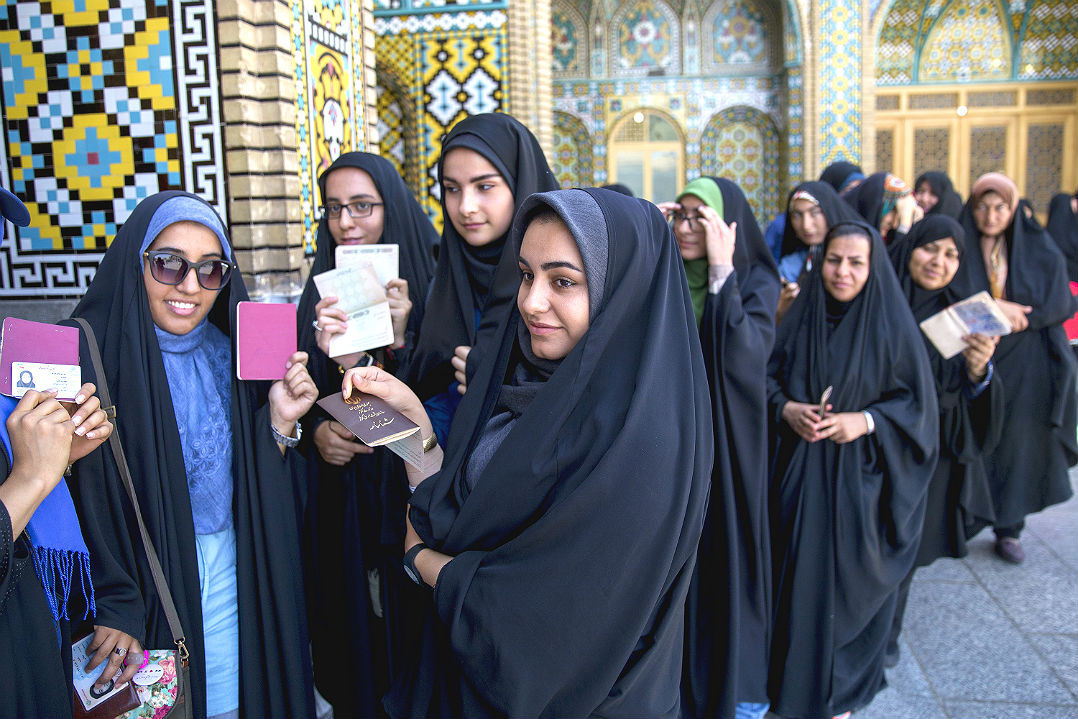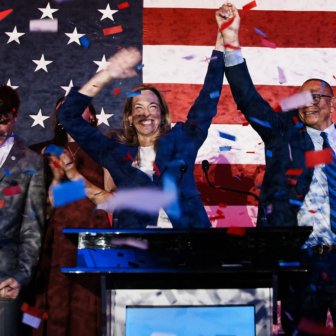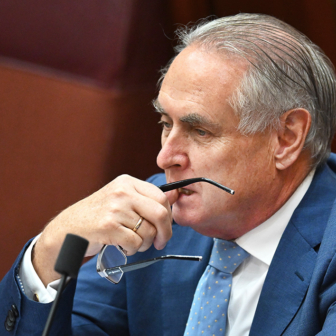Members of the US congress can’t agree on much these days, but they still seem to believe that getting involved in the affairs of the Middle East is a “cakewalk.” In a display of bipartisan unity on 15 June, the Senate voted 98–2 for new sanctions against Iran. Their unified bravado echoed the Arab Islamic American Summit in Riyadh on 20–21 May, where Donald Trump urged that “all nations of conscience must work together to isolate” Iran. Saudi Arabia’s King Salman bin Abdulaziz – the ruler of a kingdom that has spawned Wahhabism, al Qaeda and Isis – chimed in, calling Iran “the spearhead of global terrorism.”
Funds to the tune of $110 billion were promised to the Saudis to buy what President Trump describes as “lots of beautiful military equipment because nobody makes it like the United States.” US secretary of state Rex Tillerson maintained that the deal was directed at preventing “malign Iranian influence” and went on to assert American support for those “elements inside of Iran that would lead to a peaceful transition of that government.”
In between these two events, on 7 June, twin Islamic State attacks targeted two of Tehran’s most symbolic sites, Iran’s parliament and the tomb of Ayatollah Khomeini, killing many civilians. The attacks were motivated by Islamic State’s belief that the Shi’a, who dominate in Iran, are apostates. Iran’s Revolutionary Guards accused the Saudis of “complicity.”
In the United States, the Republican congressman Dana Rohrabacher described the attacks in Tehran as a “good thing,” adding that “it’s a good idea to have radical Muslim terrorists fighting each other.” President Trump’s response was to “underscore that states that sponsor terrorism risk falling victim to the evil they promote.” The military and economic pressures seemed designed to escalate an already dangerous confrontation. Equally strikingly, they also overshadow developments taking place inside Iran that hold out the possibility of a very different future.
After all, the Riyadh summit had begun just a day after a landslide re-election victory by Iran’s president Hassan Rouhani, who sealed Iran’s nuclear deal with world powers during his first four-year term. At campaign rallies and in televised presidential debates, Rouhani promised to bolster civil society, fight corruption and open up Iran to the world, going beyond the normal realm of Iranian electioneering rhetoric. He attacked human rights abuses and spoke of the populace’s disapproval of the “executions and jailings throughout the last thirty-eight years.” He denounced the group of young extremists who stormed the Saudi embassy in Tehran in January 2016 for stoking regional tensions. He accused the Revolutionary Guards of trying to sabotage the nuclear deal by writing anti-Israeli messages on test-missiles, and scorned their “cheering” of Trump’s pre-election promise that, in Rouhani’s words, “he would tear up the [nuclear] agreement.”
Rouhani had gained the endorsements of many prominent political figures, including Mohammad Khatami, the former reformist president (1997–2005), as well as Mir-Hossein Mousavi and Mehdi Karroubi, key protagonists of the “Green Movement” that erupted after the contested 2009 presidential election, who are now under house arrest. In the end, his victory over the conservative Ebrahim Raisi was decisive, by 57 to 38 per cent on a 72 per cent turnout.
Earlier, the parliamentary elections of February 2016 had seen reformists gain a working majority in the Iranian majlis. Many conservative MPs and prominent opponents of the nuclear deal were decisively rejected by voters. The city and village council elections, held on the same day as the presidential vote, also saw sweeping victories. In the key Tehran city council, all twenty-one seats were won by reformists, six of them women.
Ayatollah Ahmad Jannati, the head of the powerful Guardian Council, which vets all parliamentary candidates, described these elections as a “vast calamity.” The vetting of candidates for council elections is carried out by designated local parliamentary groups, circumventing the Guardian Council. In April, Jannati issued a communique that “non-Muslims” and religious minorities be barred from running. The reformist-dominated parliament ignored the Council’s assertion that the ruling was binding.
City and village council elections were initiated in 1999, and are a legacy of Mohammad Khatami’s efforts to strengthen civil society during his presidency. In one province alone – Sistan and Baluchistan, a predominantly Sunni province bordering Pakistan and Afghanistan – 415 women councillors. In the village of Afzalabad, ten out of the eleven candidates were women. One candidate, a thirty-three-year-old named Farahnaz, told reporters that “our men are either border guards or farmers; they do not have time to deal with village affairs.” Having gained her high school diploma, she had given up a university place after family opposition. Her aim was to improve paths to further education, because “educated women can create jobs.”
Fatemeh Kazemi is the returning councillor for the village of Beshareh, near the holy city of Qom in Iran’s conservative heartland. One of six sisters, she is single, believing that “marriage would create limitations for me.” When she was elected, not a single woman in her village had health insurance. She tapped into regional training and job creation schemes that allowed the women to work as carpet weavers, and managed to gain insurance cover for them. “When a lady can pay her own way, why freeload or get beaten on the head?” Kazemi says she told the women.
Another councillor, Nahid Eskandary, returned to her ancestral hometown of Sarakan equipped with a degree in law and criminology. She recounts having to overcome sexist attitudes and a local governor who persistently ignored her. With determination and after manoeuvring around the caveats of the health ministry’s funding programs, she established a screening clinic that offers mammograms, ultrasound and health checks to the residents. In Shahrekord, in Iran’s Kurdistan province, Parichehr Soltani argues that “society will not be developed” until women are fully represented in the political process, as “unfortunately some of our men are a hundred years behind the times.” Soltani was a prominent campaigner for Rouhani, maintaining that supporting him “would keep the shadow of war and sanctions at bay” and allow opportunities for women to continue to grow.
Only time will tell if such civic activism will increase accountability and prove to be “great free schools” of democracy. For now, a bulletproof glass ceiling bars women from running in the presidential race, and countless obstacles are placed in the way of political candidates in Iran. For many, though, the council elections have been a path to more senior positions. The governor of Hamoun, Masoumeh Parandvar, recalls telling the state governor, “I don’t want to be the token woman governor on display,” to which the governor responded, “Well, prove that a woman can do the job.” Parandvar maintains that ultimately constituents “don’t care about your sex” as long as you get the work done.
All this may well read like a list of inconsequential anecdotes, especially as it is often said that elections in Iran don’t herald tangible change. Yet these examples should not be too easily discounted. It was the city and village council elections of 2003 that saw Mahmoud Ahmadinejad elected mayor of Tehran, paving the way to his becoming president two years later. His 2003 victory was made possible by a 12 per cent turnout during a voting boycott by many who had lost hope in the promises of the reformist government.
The decisive election victory of reformists in 1997 had inspired hope in the electorate. Khatami’s victory was based on an astounding 90 per cent turnout, of which he garnered 70 per cent of the votes. His tenure saw a temporary blossoming of grassroots movements and of the press. Even relations with the United States seemed on the up, and Iran actively supported the US campaign in Afghanistan after 9/11. Yet the government faced a brutal backlash at home and met with hostility abroad, with president George W. Bush branding Iran as part of “an axis of evil.” Khatami’s promise to end economic and political isolation collapsed, allowing the belligerent Ahmadinejad to come to the fore.
Following Ahmadinejad’s dubious re-election in June 2009, Iran saw the largest street protests in the history of the Islamic Republic. The demonstrators’ unifying mantra was “where is my vote?” They met a brutal crackdown: killings, arrests and purges. With the election of Rouhani and the signing of the nuclear accord, many Iranians believed that they were about to consign a revolutionary clique that thrived on war and isolation to the dustbin of history.
Zohreh, a senior academic sacked from her job following the purge of university faculties during Ahmadinejad’s tenure, describes her reaction to Rouhani’s re-election as “cautiously hopeful.” “For years I’ve lived with the sense of fear,” she goes on, “trying to second-guess people around me as I make my way round Tehran. Now they have to look over their shoulders knowing that we are the majority, we have the councils, parliament and now the presidency – and we made it impossible for them to steal our votes again.”
But she adds, “Let’s just hope there’s not another war.” Like many Iranians, she cannot ignore the eerily familiar pounding drums. In 1980, Saddam Hussein’s Iraq invaded Iran, starting a war that would go on for eight long years and leave more than a million dead. Iraq was backed by the United States and its Western allies; Saudi and Gulf rulers fearful of Iranian-style uprisings joined in.
“It’s a pity both sides can’t lose” was Henry Kissinger comment on that war. Saudi Wahhabism was championed as a counter to the Shi’a by the United States and its allies, and its extreme ideology spread to mosques around the world, from the streets of Karachi and Mumbai to Brussels, Paris and London. Then the “war on terror” made Syria, Afghanistan and Iraq a hospitable breeding-ground for extremist groups. The precursor of Islamic State/Daesh was founded in 1999 by Jordanian radical Abu Musab al-Zarqawi; it thrived in the battlefields of Afghanistan and grew more powerful during the ensuing conflicts in Iraq and Syria, sending millions of people in search of refuge. The deadly wars of the Middle East now play out in Western capitals, and the “great game” is no longer a spectator sport. In the end, we were all losers.
The opening salvo of the Iran-Iraq war began on 30 April 1980 with the siege of the Iranian embassy in London. The building was seized by a quasi-Iranian Sunni Arab “separatist” group, trained and equipped by the Iraqi regime, which claimed to be acting on behalf of Iran’s deprived border province of Khuzestan. There is no denying the difficulties that face that area of Iran, or others such as Kurdistan. But unlike much of the Middle East, the borders of Iran date back over two millennia; they are not lines in the sand drawn in 1916 by Messrs Sykes and Picot. The Arabs of Khuzestan were at the bitter frontline of the Iran–Iraq war, but a much-touted “fifth column” didn’t transpire then and is unlikely to emerge today.
What always emerges from war is brutality and retribution, hawks and jingoes. Before that war, in its post-revolutionary ferment, Iran had myriad political groups. Once the war began, they became brothers in arms fighting a greater enemy. The 1979 revolution and the aftermath of the Arab Spring are proof enough that the mere fall of dictators does not free a people.
Iranians know too well that freedom must come from within. During Iran’s constitutional revolution of 1906, hopes of democracy were dashed and authoritarian rule was implemented with the help of colonial powers. A generation later, the democratically elected government of Mohammad Mossadegh was finished off in a coup backed by the United States and Britain.
What has emerged today is an Iranian populace that voted in large numbers for civil liberties and greater engagement with the world. They again face entrenched opposition at home and hostility abroad in their uphill struggle for democratic change. •




